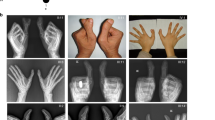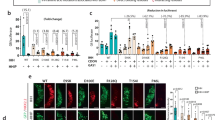Abstract
Brachydactyly type A1 (BDA1) was the first recorded disorder of the autosomal dominant Mendelian trait in humans, characterized by shortened or absent middle phalanges in digits. It is associated with heterozygous missense mutations in indian hedgehog (IHH)1,2. Hedgehog proteins are important morphogens for a wide range of developmental processes3,4. The capacity and range of signalling is thought to be regulated by its interaction with the receptor PTCH1 and antagonist HIP1. Here we show that a BDA1 mutation (E95K) in Ihh impairs the interaction of IHH with PTCH1 and HIP1. This is consistent with a recent paper showing that BDA1 mutations cluster in a calcium-binding site essential for the interaction with its receptor and cell-surface partners5. Furthermore, we show that in a mouse model that recapitulates the E95K mutation, there is a change in the potency and range of signalling. The mice have digit abnormalities consistent with the human disorder.
This is a preview of subscription content, access via your institution
Access options
Subscribe to this journal
Receive 51 print issues and online access
$199.00 per year
only $3.90 per issue
Buy this article
- Purchase on Springer Link
- Instant access to full article PDF
Prices may be subject to local taxes which are calculated during checkout




Similar content being viewed by others
References
Gao, B. et al. Mutations in IHH, encoding Indian hedgehog, cause brachydactyly type A–1. Nature Genet. 28, 386–388 (2001)
McCready, M. E., Grimsey, A., Styer, T., Nikkel, S. M. & Bulman, D. E. A century later Farabee has his mutation. Hum. Genet. 117, 285–287 (2005)
Hooper, J. E. & Scott, M. P. Communicating with Hedgehogs. Nature Rev. Mol. Cell Biol. 6, 306–317 (2005)
Jiang, J. & Hui, C. C. Hedgehog signaling in development and cancer. Dev. Cell 15, 801–812 (2008)
McLellan, J. S. et al. The mode of Hedgehog binding to Ihog homologues is not conserved across different phyla. Nature 455, 979–983 (2008)
Wallis, D. & Muenke, M. Mutations in holoprosencephaly. Hum. Mutat. 16, 99–108 (2000)
Hellemans, J. et al. Homozygous mutations in IHH cause acrocapitofemoral dysplasia, an autosomal recessive disorder with cone-shaped epiphyses in hands and hips. Am. J. Hum. Genet. 72, 1040–1046 (2003)
Zhu, J. et al. Uncoupling Sonic hedgehog control of pattern and expansion of the developing limb bud. Dev. Cell 14, 624–632 (2008)
Kronenberg, H. M. Developmental regulation of the growth plate. Nature 423, 332–336 (2003)
St-Jacques, B., Hammerschmidt, M. & McMahon, A. P. Indian hedgehog signaling regulates proliferation and differentiation of chondrocytes and is essential for bone formation. Genes Dev. 13, 2072–2086 (1999); erratum 13, 2617 (1999)
Fuse, N. et al. Sonic hedgehog protein signals not as a hydrolytic enzyme but as an apparent ligand for patched. Proc. Natl Acad. Sci. USA 96, 10992–10999 (1999)
Vortkamp, A. et al. Regulation of rate of cartilage differentiation by Indian hedgehog and PTH-related protein. Science 273, 613–622 (1996)
Tenzen, T. et al. The cell surface membrane proteins Cdo and Boc are components and targets of the Hedgehog signaling pathway and feedback network in mice. Dev. Cell 10, 647–656 (2006)
Chuang, P. T. & McMahon, A. P. Vertebrate Hedgehog signalling modulated by induction of a Hedgehog-binding protein. Nature 397, 617–621 (1999)
Seemann, P. et al. Activating and deactivating mutations in the receptor interaction site of GDF5 cause symphalangism or brachydactyly type A2. J. Clin. Invest. 115, 2373–2381 (2005)
Cheung, M. & Briscoe, J. Neural crest development is regulated by the transcription factor Sox9. Development 130, 5681–5693 (2003)
Ericson, J. et al. Pax6 controls progenitor cell identity and neuronal fate in response to graded Shh signaling. Cell 90, 169–180 (1997)
Lettre, G. et al. Identification of ten loci associated with height highlights new biological pathways in human growth. Nature Genet. 40, 584–591 (2008)
Weedon, M. N. et al. Genome-wide association analysis identifies 20 loci that influence adult height. Nature Genet. 40, 575–583 (2008)
Mak, K. K., Chen, M. H., Day, T. F., Chuang, P. T. & Yang, Y. Wnt/β-catenin signaling interacts differentially with Ihh signaling in controlling endochondral bone and synovial joint formation. Development 133, 3695–3707 (2006)
Niedermaier, M. et al. An inversion involving the mouse Shh locus results in brachydactyly through dysregulation of Shh expression. J. Clin. Invest. 115, 900–909 (2005)
Sanz-Ezquerro, J. J. & Tickle, C. Fgf signaling controls the number of phalanges and tip formation in developing digits. Curr. Biol. 13, 1830–1836 (2003)
Saha, K. & Schaffer, D. V. Signal dynamics in Sonic hedgehog tissue patterning. Development 133, 889–900 (2006)
Gong, Y. et al. Heterozygous mutations in the gene encoding noggin affect human joint morphogenesis. Nature Genet. 21, 302–304 (1999)
Polinkovsky, A. et al. Mutations in CDMP1 cause autosomal dominant brachydactyly type C. Nature Genet. 17, 18–19 (1997)
Meyers, E. N., Lewandoski, M. & Martin, G. R. An Fgf8 mutant allelic series generated by Cre- and Flp-mediated recombination. Nature Genet. 18, 136–141 (1998)
McLeod, M. J. Differential staining of cartilage and bone in whole mouse fetuses by alcian blue and alizarin red S. Teratology 22, 299–301 (1980)
Tsang, K. Y. et al. Surviving endoplasmic reticulum stress is coupled to altered chondrocyte differentiation and function. PLoS Biol. 5, e44 (2007)
Wai, A. W. et al. Disrupted expression of matrix genes in the growth plate of the mouse cartilage matrix deficiency (cmd) mutant. Dev. Genet. 22, 349–358 (1998)
Nagy, A., Gertsenstein, M., Vintersten, K. & Behringer, R. R. Manipulating the Mouse Embryo. A Laboratory Manual (Cold Spring Harbour Laboratory Press, 2003)
Lee, K. et al. Parathyroid hormone-related peptide delays terminal differentiation of chondrocytes during endochondral bone development. Endocrinology 137, 5109–5118 (1996)
Bitgood, M. J. & McMahon, A. P. Hedgehog and Bmp genes are coexpressed at many diverse sites of cell–cell interaction in the mouse embryo. Dev. Biol. 172, 126–138 (1995)
Mundlos, S. Skeletal morphogenesis. Methods Mol. Biol. 136, 61–70 (2000)
Spater, D. et al. Wnt9a signaling is required for joint integrity and regulation of Ihh during chondrogenesis. Development 133, 3039–3049 (2006)
Crossley, P. H. & Martin, G. R. The mouse Fgf8 gene encodes a family of polypeptides and is expressed in regions that direct outgrowth and patterning in the developing embryo. Development 121, 439–451 (1995)
Haaf, T. High-resolution analysis of DNA replication in released chromatin fibers containing 5-bromodeoxyuridine. Biotechniques 21, 1050–1054 (1996)
Schmahl, J., Eicher, E. M., Washburn, L. L. & Capel, B. Sry induces cell proliferation in the mouse gonad. Development 127, 65–73 (2000)
Adra, C. N., Boer, P. H. & McBurney, M. W. Cloning and expression of the mouse pgk-1 gene and the nucleotide sequence of its promoter. Gene 60, 65–74 (1987)
Taipale, J. et al. Effects of oncogenic mutations in Smoothened and Patched can be reversed by cyclopamine. Nature 406, 1005–1009 (2000)
Logan, M. & Tabin, C. Targeted gene misexpression in chick limb buds using avian replication-competent retroviruses. Methods 14, 407–420 (1998)
Hamburger, V. & Hamilton, H. L. A series of normal stages in the development of the chick embryo. 1951. Dev. Dyn. 195, 231–272 (1992)
Niwa, H., Yamamura, K. & Miyazaki, J. Efficient selection for high-expression transfectants with a novel eukaryotic vector. Gene 108, 193–199 (1991)
Briscoe, J., Chen, Y., Jessell, T. M. & Struhl, G. A hedgehog-insensitive form of Patched provides evidence for direct long-range morphogen activity of sonic hedgehog in the neural tube. Mol. Cell 7, 1279–1291 (2001)
Acknowledgements
This work was supported by grants from the Research Grants Council and University Grants Council of Hong Kong (N_HKU705/02, HKU2/02C and AoE/M-04/04), and The National Key Scientific Program (2007CB947300). We thank P. Tam for suggestions and comments, P. Beachy and D. Leahy for sharing unpublished data, and K. Leung for blastocyst injections.
Author Contributions The primary affiliation for J.H. is Bio-X Center, Shanghai Jiao Tong University. B.G. and J.H. designed and performed the experiments and analysed the data. K.F.L. performed the in vitro hedgehog signalling assay. F.W., S.S. and S.M. were involved in the in situ analysis of digit formation, micromass cultures and revision of the manuscript. M.C. and J.B. assisted in the chick neural tube electroporation experiments. G.M. performed the PTCH1 competitive binding assay. L.H. was involved in experimental design and manuscript revision. K.S.E.C. was involved in experimental design, generation of the BDA1 mouse, data analysis, interpretation and manuscript revision. D.C. coordinated the experimental design, analysed the data, and together with B.G. and J.H. interpreted the results and wrote the manuscript.
Author information
Authors and Affiliations
Corresponding authors
Supplementary information
Supplementary Figures
This file contains Supplementary Figures 1-7 with Legends (PDF 3768 kb)
Rights and permissions
About this article
Cite this article
Gao, B., Hu, J., Stricker, S. et al. A mutation in Ihh that causes digit abnormalities alters its signalling capacity and range. Nature 458, 1196–1200 (2009). https://doi.org/10.1038/nature07862
Received:
Accepted:
Published:
Issue Date:
DOI: https://doi.org/10.1038/nature07862
This article is cited by
-
Suppression of apoptosis impairs phalangeal joint formation in the pathogenesis of brachydactyly type A1
Nature Communications (2024)
-
Prenatal diagnosis to identify compound heterozygous variants in PKDCC that causes rhizomelic limb shortening with dysmorphic features in a fetus from China
BMC Medical Genomics (2023)
-
DNA methylation analysis reveals epimutation hotspots in patients with dilated cardiomyopathy-associated laminopathies
Clinical Epigenetics (2021)
-
Deletion of 2 amino acids in IHH in a Japanese family with brachydactyly type A1
BMC Medical Genomics (2021)
-
Altered microRNAs in C3H10T1/2 cells induced by p.E95K mutant IHH signaling
Hereditas (2021)
Comments
By submitting a comment you agree to abide by our Terms and Community Guidelines. If you find something abusive or that does not comply with our terms or guidelines please flag it as inappropriate.



